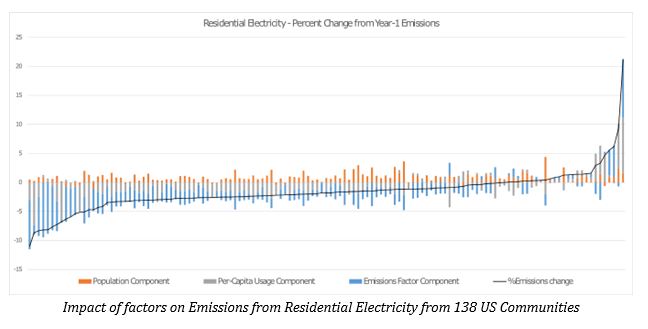ICLEI-Local Governments for Sustainability USA released at Global Climate Action Summit a report summarizing the major determinants of community-scale performance in reducing greenhouse gas emissions. Released in partnership with numerous other reports detailing the scale of action among business, regions, and local government, this analysis is the first to report on the collective progress of the many U.S. Cities that have been tracking emissions and taking action on climate for a number of years.
DOWNLOAD THE REPORT
What’s Driving Changes in Local GHG Emissions? Results from Contribution Analysis illustrates the
Supported by a financial assistance from the U.S. Department of Energy’s Cities Leading through Energy Analysis and Planning (Cities-LEAP) project and led by the City of Bellevue, Washington, ICLEI-USA developed the new methodology in partnership with a steering committee of the following communities and regions:
Aspen, Colorado;
Bellevue, Washington;
Delaware Valley Regional Planning Commission
King County, Washington;
Santa Monica, California;
Metropolitan Washington Council of Governments
An additional group of pilot communities contributed to the testing of the methodology and toolkit:
Portland, Oregon;
Ashland, Oregon;
Cleveland, Ohio;
Denver, Colorado;
Durham, North Carolina;
Hayward, California;
Miami-Dade County, Florida;
Olympia, Washington;
Nashville-Davidson County, Tennessee;
Shoreline, Washington
In addition, the report includes an analysis of a limited set of factors applied to the GHG inventories of 138 communities with multiple benchmark years to observe these trends on a much wider scale.
The methodology, referred to as the “contribution analysis” or “decomposition analysis” is now available in a toolkit and guidance document. The replicable method allows any city, county, or region to evaluate community-wide energy and GHG emissions performance attributable to local climate action. This enhanced view results in a deeper understanding of the actions that drive emissions changes, resulting in an ability to better prioritize future actions based on past performance.
Find out more about Contribution Analysis and download the toolkit here.
Support from Participating Cities
City of Aspen Mayor Steven Skadron in San Francisco participating in the Global Action Climate Summit said, “Aspen was a pilot city and we plan to use the Contribution Analysis to refine our climate planning work and apply resources to greenhouse gas drivers that might have gone unaddressed. As a city that strives to build replicable and scalable solutions, we’re thrilled that this tool will be available to cities of all sizes.”
Presenting the report at the Global Climate Action Summit, Mike Steinhoff, Tools and Technical Director, ICLEI USA said: “Cities regularly tracking and disclosing GHG emissions is beginning to build a dataset that allows us to ask new questions and think about performance in new ways. Having good data on what impacts emissions will be critical for guiding more effective climate action.”
Jennifer Ewing, Environmental Stewardship Program Manager, City of Bellevue, said, “The Contribution Analysis toolkit allows us to understand what is driving the changes in our emissions inventory, and helps us understand that despite significant population and job growth in the city, we are making progress in increasing energy efficiency and reducing emissions.
“The contribution analysis shows the importance of switching to cleaner fuel sources and reducing VMT (vehicle miles traveled) per person in overall emissions reductions,” said Maia Davis, Senior Environmental Planner, Metropolitan Washing Council of Governments. “Energy, land-use, and transportation planning are key focus areas of the Council of Governments’ overall work.”
Matt Kuharic, Climate Change Program Coordinator, King County, WA, said: “In the last decade, the population in King County has grown by more than 10%, but emissions have remained flat. While we’ve seen an important decoupling of emissions and population growth, the analysis shows that we need to do much more to phase in renewable energy sources, develop clean transportation options, and make our homes and buildings more efficient.”
“ICLEI’s contribution analysis methodology allows for quick and easy analysis and clear communication of the multiple factors driving changes to greenhouse gas emissions from one period to another,” said Robert Graff, Manager, Office of Energy and Climate Change Initiatives at the Delaware Valley Regional Planning Commission. “The toolkit boils down the varying impacts of all these factors into one easy-to-understand graphic, which DVRPC features prominently in our 2015 inventory.”
“Seeing what factors impact your emissions is powerful. This project opens up the ‘black box’ of GHG inventories. It helps agencies to focus on the areas they can affect the most,” said Garrett Wong, Senior Sustainability Analyst, City of Santa Monica, CA.
